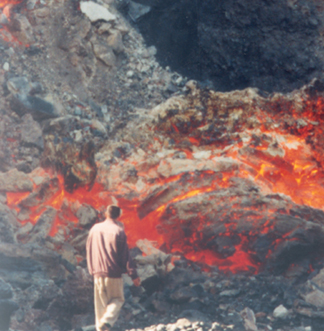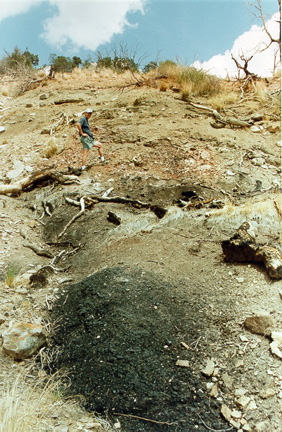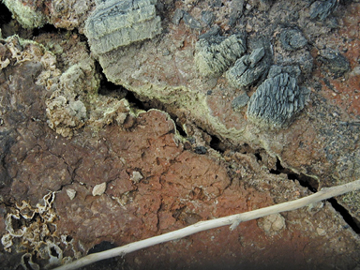Geophenomena
Coal
Fires: A Burning Global Recipe for Catastrophe
Glenn
B. Stracher
Additional Reading
I first contacted Anupma Prakash a couple of years ago to learn more about
coal fires around the world and their associated health and environmental impacts.
Problematic coal fires refer to the combustion of coal in underground seams,
in culm banks (where miners pile coal refuse from their excavations) or in storage
facilities.
 Prakash, who
is an associate professor of geology at the University of Alaska-Fairbanks,
took photographs of flames leaping into the air from coal fires in India and
China that dramatically illustrate how newly exposed coal seams can ignite to
dangerous levels. “Such flames show up only when there is a sudden fresh
collapse of the coal seam or a new coal surface is exposed while opencast mining
is in progress,” Prakash tells me.
Prakash, who
is an associate professor of geology at the University of Alaska-Fairbanks,
took photographs of flames leaping into the air from coal fires in India and
China that dramatically illustrate how newly exposed coal seams can ignite to
dangerous levels. “Such flames show up only when there is a sudden fresh
collapse of the coal seam or a new coal surface is exposed while opencast mining
is in progress,” Prakash tells me.
But such flames are rare, she says. Coal fires frequently burn beneath the surface,
and the damage they wreak on the environment and to human health is the result
of sulfur and other toxins condensing onto soil, entering streams and groundwater
or transferring into the atmosphere. And while the damage is extensive and often
includes land subsidence from the underground burning, too often little is done
to understand and prevent coal fire catastrophes from devastating forests and
threatening or destroying communities.
A surface coal seam in an opencast
mining area in the Rujigou coalfield in China collapses due to fires. The coal
seam consisting of tens of meters of high quality bituminous to anthracite coal
reduces to centimeters of ash and rubble on being burnt. Image courtesy of Anupma
Prakash
I earned my doctorate in structural geology, focusing on the engineering aspects
of stress and strain. I wanted to understand rock mechanics and how rocks deform
and break. I didn’t think of coal fires as contributing to such problems
until I began my first teaching job, at Bloomsburg State University in Pennsylvania,
near the coal fire burning beneath Centralia (Geotimes, October 2000). While
I had heard about the Centralia fire and how the town’s decision to burn
landfill trash had ignited the Buck anthracite seam years earlier, I had never
visited the site. When the geology department took a field trip to Centralia,
I saw cracks in the road and valleys billowing with smoke. Sulfur and coal ash
covered entire forested areas. The community had evacuated in response to the
dangers of poisonous gas and subsidence. This was a geological catastrophe in
action — induced originally by people — but prohibitive cost and difficulties
meant little was being done to extinguish the fire.
The Centralia fire continues to burn today as do many other coal fires around
the world. While coal fires have occurred naturally in the past during the Pleistocene
and the Tertiary, millions of years before opencast and deep coal mining, human
activity has promoted the proliferation and severity of these fires since the
industrual revolution.
I’ve been following coal fires ever since my visit to Centralia. Except
for a small, brave group of dedicated people around the globe, some of whom
I have noted in this article, it is a problem few others are studying. The work
is dangerous and not without difficulties. Once started, coal fires can burn
for years before cannibalizing their source of fuel. But there are many ways
to fight such fires. Understanding the threat is the first step.
Northern China on fire
Coal production in China meets the fuel demands for about three-fourths of
the country’s energy requirements, but not without cost to the environment
and people. Coal fires, some burning for centuries, plague Ningxia, Xinjiang
and numerous provinces across northern China from Heilongjiang in the east to
Qinghai in the west. The Ningxia Hui and Xinjiang Uygur autonomous regions in
north-central and northwest China, respectively, contain most of China’s
coal reserves. Lightning, spontaneous combustion, and legal and illegal mining
operations on all scales are responsible for most of the fires.
Andries Rosema of the Environmental Analysis and Remote Sensing (EARS) firm
in the Netherlands worked with colleagues using satellite and airplane data
to analyze the damage uncontrolled fires caused in China. The team found that
the fires released up to 360 million metric tons of carbon dioxide — 2
to 3 percent of worldwide production per year from burning fossil fuels, an
amount equivalent to that emitted per year from all automobiles and light trucks
in the United States. The economic loss of coal from these fires is as high
as US$125 million to US$250 million, estimates Zhang Xiangmin of the International
Institute for Geo-Information Science and Earth Observation (ITC) in the Netherlands.
Reports from the World Bank, World Resources Institute, and United Nations Development
Program confirm that China’s atmospheric pollution, primarily from coal
combustion, is among the highest in the world. Coal gas and particulate matter
are responsible for acid rain and human disease in more than 100 Chinese cities
and the problems have spilled into other countries including Japan, Korea, the
Philippines and Taiwan. Lung cancer, bronchitis, stroke, pulmonary heart disease,
and chronic obstructive pulmonary disease — which accounts for up to 26
percent of all deaths in China — are on the rise. In some cases, such health
effects are directly linked to coal emissions from indoor cooking and heating
(Geotimes, November 2001).
Modern technology is assisting fire fighters in China. Optical and thermal images
help in determining the location, size, depth, burning intensity, temperature,
propagation direction and coal consumption of a fire. The Beijing Remote Sensing
Corp., working with ITC, EARS and the Netherlands Institute of Applied Geo-Science,
is integrating numerical modeling with geographic information systems software
to generate fire-fighting maps and images of subsurface fires and to plan fire-fighting
activities in the field.
Unfortunately, “numerous fires are cost-prohibitive to extinguish and are
allowed to burn unchecked,” Prakash says.
Colorado’s tribal concerns
In the United States, fires have burned for decades in numerous coal-producing
states. According to the Office of Surface Mining of the U.S. Department of
the Interior, more than $651 million is needed to control these fires in abandoned
underground workings alone.
 The Southern
Ute Indian Nation’s Department of Energy in Ignacio, Colo., is playing
a major role in trying to cool down and control the spread of subsurface coal
fires endangering forests and fauna. The underground heat sources are promoting
subsidence and accelerating erosion in the Cinder Buttes area of La Plata County.
Dick Baughman, the tribal geologist, is responsible for reconnaissance surveys
and temperature measurements in the field. “Part of my job is to protect
the forest,” Baughman says.
The Southern
Ute Indian Nation’s Department of Energy in Ignacio, Colo., is playing
a major role in trying to cool down and control the spread of subsurface coal
fires endangering forests and fauna. The underground heat sources are promoting
subsidence and accelerating erosion in the Cinder Buttes area of La Plata County.
Dick Baughman, the tribal geologist, is responsible for reconnaissance surveys
and temperature measurements in the field. “Part of my job is to protect
the forest,” Baughman says.
Subsurface burning is responsible
for subsidence in parts of LaPlata County, Colo. Here the pre-burn surface was
originally at the elevation at the top of the photo. Dick Baughman is standing
on rock chemically weathered from coal-fire gas, also responsible for killing
vegetation. The coal bed in the foreground dips approximately 12 degrees into
the hillside. Photo by G. Stracher.
I had collected some condensation products from a vent in the area in May of
2001, and was careful to have colleagues watch me as I held my breath to keep
from inhaling the fumes. In August, Baughman told me that a vent 30 feet away
measured concentrations of hydrogen sulfide that could kill a person with a
single gulp of air. When Baughman works with colleagues to take temperature
measurements, he hangs a gas detector over the vent that measures the concentration
of hydrogen sulfide.
When they need to extinguish a fire, each person wears a hydrogen sulfide gas
detector. “During mitigation attempts a safety person watches, and when
anyone’s hydrogen sulfide gas detector sounds the alarm he makes sure everyone
is evacuated to a safe area,” Baughman says. “If a vent was exhausting
high hydrogen sulfide concentrations during normal field reconnaissance, I would
just stay away from it.”
To help extinguish the fires, Baughman directs fire fighters to problematic
surface vents and fissures: the external manifestation of the ires below. The
fire fighters, wearing protective gear, venture near explosive levels of methane
and extremely toxic concentrations of hydrogen sulfide and sulfur dioxide to
pump a grout consisting of fly-ash concrete and Thermocell coolant into the
orifices. The grout starves the fires of oxygen and cools the fire down, but
sometimes the sealant cracks. Results have left Baughman skeptical that the
fires can be extinguished. The fires may cool down and stop encroaching into
an undesirable area, but vents and fissures with temperatures as high as 1400
degrees Fahrenheit constantly reappear.
 Working with
Baughman this summer, I saw just how dangerous these fires can be as I watched
a grout-filled vent-fissure system develop a crack and, within a day, release
sulfur that had condensed from the exhaled gas. Such fast reaction kinetics
enable toxic materials to quickly get into the groundwater, soil or streams.
If the condensed sulfur mixes with rain or water, it turns into sulfuric acid
which washes into the soil.
Working with
Baughman this summer, I saw just how dangerous these fires can be as I watched
a grout-filled vent-fissure system develop a crack and, within a day, release
sulfur that had condensed from the exhaled gas. Such fast reaction kinetics
enable toxic materials to quickly get into the groundwater, soil or streams.
If the condensed sulfur mixes with rain or water, it turns into sulfuric acid
which washes into the soil.
Vents in Indonesia emit toxic gases that
form a green condensation of sulfur. Alfred E. Whitehouse et al.
India’s coal fires
displacing people
In 1894, commercial mining began in India’s largest coalfield — the
Jharia coalfield (JCF) north of the Damodar River in the state of Bihar. Coal
production in India supplies two-thirds of the country’s energy requirements
but, as in China, not without cost to the environment and India’s people.
Historical documents from Bharat Coaking Coal Limited (BCCL) in Bihar reveal
that the first fire broke out in 1916 and that by the 1960s fires had spread
throughout the entire coalfield. BCCL reports that most fires began by spontaneous
combustion before opencast or strip mining; or by deep, underground mining because
of exploitation without fire-prevention codes, now in place. In addition, “some
JCF fires began in abandoned deep mines used as hideouts for the illegal distillation
of alcohol,” Prakash says. Currently, about 37 million tons of coal are
lost to JCF fires.
Many large communities of people have relocated from the Jharia region to escape
land subsidence and high concentrations of toxic coal gas and particulate matter.
But the move is made difficult because of inoperable rail lines. The Government
of India and Ministry of Coal are assisting with relocation funds. Regardless,
the pollution is still causing people to suffer from asthma, chronic bronchitis,
skin diseases and lung diseases.
Although fire-fighting techniques ranging from trenching for surface fires
to inert gas injection for subsurface fires are used to combat the coal fires,
BCCL reports that many large fires rage on because of inaccessible deep mines
and the risk of subsidence.
The Asian Brown Haze
According to recent findings released in August by scientists with the United
Nations Environment Programme (UNEP) — including Nobel laureate Paul Crutzen
of the Max-Planck Institute for Chemistry in Germany, Ashesh P. Mitra of the
National Physical Laboratory in India, and Veerabhadran Ramanathan of the Scripps
Institution of Oceanography in the United States — burning fossil fuels
in Asia are contributing to the expanding, three-kilometer thick Asian Brown
Haze.
This cloud of particulate matter, acids and aerosols stretches across South
Asia from Afghanistan to Sri Lanka. In the first half of the 1990s it contributed
an estimated 60,000 human respiratory fatalities in India alone. It is responsible
for crop failures induced by acid rain and for a 10 to 15 percent reduction
in sunlight reaching the surface in South Asia, thereby altering weather patterns
from drought in Pakistan to flooding in Bangladesh. Preliminary UNEP findings
indicate the haze problem may be worse over China.
This cloud has the potential to coalesce with others around the world generated
by coal fires and other sources of atmospheric pollution. The potential global
consequences are frightening.
Stracher is an
associate professor of geology at East Georgia College in Swainsboro, Ga. He is
accepting manuscripts for a symposium on coal fires around the world that he will
convene during the American Association for the Advancement of Science meeting
in Denver, Colo., in February 2003. E-mail
him. Anupma Prakash of the University of Alaska-Fairbanks and Geotimes
associate editor Christina Reed contributed to this story.
Additional
reading:
Stracher, G.B., Taylor, T.P., and Prakash, A., 2002, Coal Fires: A Synopsis
of Their Origin, Remote Sensing Detection, and Thermodynamics of Sublimation,
in Shannon, S., editor, Case Histories of Mine Reclamation and Regulation, Environmental
Technology for Mining: Robertson GeoConsultants Inc., Reno, NV; Vancouver, B.C.,
p. 1-8. Link to InfoMine.
United Nations Environment Programme Report
56, August 22, 2002.
Prakash, A., Fielding, E.J., Gens, R., Genderen, J.L. van, and Evans, D.L.,
2001, Data fusion for investigating land subsidence and coal fire hazards in
a coal mining area. International Journal of Remote Sensing, V. 22, No.
6, pp. 921-932.
World Coal Institute, 2000, Coal-power
for progress, 4th edition. London, England.
Coates, D.A. and Heffern, E.L., 2000, Origin and geomorphology of clinker
in the Powder River Basin, Wyoming and Montana: in Miller, W.R., ed., Coal bed
methane and Tertiary geology of the Powder River Basin. Wyoming Geological
Association 50th Annual Field Conference Guidebook, pp.211-229.
Johnson, T.M., Liu, F., and Newfarmer, R., 1997. Clear water, blue skies: China's
environment in the new century. World Bank, Washington, D.C.
Stracher, G.B., 1995, The Anthracite Smokers of Eastern Pennsylvania: P-T stability
diagram by TL Analysis. Mathematical Geology, V. 27, No. 4, pp. 499-511.
U.S. Department of Energy, 1993, The fire below: Spontaneous Combustion in
Coal. Environmental Safety and Health Bulletin, No. EH- 93-4, Washington, D.C.,
pp.1-5.
Sinha, P.R., 1986. Mine fires in Indian coalfields. Energy: Vol. 11: 1147-1154.
Lapham, D.M., Barnes, J.H., Downey, W.F., Jr., and Finkelman, R.B., 1980.
Mineralogy associated with burning anthracite deposits of eastern Pennsylvania.
Pennsylvania Geological Survey Mineral Resource Report 78, Harrisburg, PA.
 Prakash, who
is an associate professor of geology at the University of Alaska-Fairbanks,
took photographs of flames leaping into the air from coal fires in India and
China that dramatically illustrate how newly exposed coal seams can ignite to
dangerous levels. “Such flames show up only when there is a sudden fresh
collapse of the coal seam or a new coal surface is exposed while opencast mining
is in progress,” Prakash tells me.
Prakash, who
is an associate professor of geology at the University of Alaska-Fairbanks,
took photographs of flames leaping into the air from coal fires in India and
China that dramatically illustrate how newly exposed coal seams can ignite to
dangerous levels. “Such flames show up only when there is a sudden fresh
collapse of the coal seam or a new coal surface is exposed while opencast mining
is in progress,” Prakash tells me. The Southern
Ute Indian Nation’s Department of Energy in Ignacio, Colo., is playing
a major role in trying to cool down and control the spread of subsurface coal
fires endangering forests and fauna. The underground heat sources are promoting
subsidence and accelerating erosion in the Cinder Buttes area of La Plata County.
Dick Baughman, the tribal geologist, is responsible for reconnaissance surveys
and temperature measurements in the field. “Part of my job is to protect
the forest,” Baughman says.
The Southern
Ute Indian Nation’s Department of Energy in Ignacio, Colo., is playing
a major role in trying to cool down and control the spread of subsurface coal
fires endangering forests and fauna. The underground heat sources are promoting
subsidence and accelerating erosion in the Cinder Buttes area of La Plata County.
Dick Baughman, the tribal geologist, is responsible for reconnaissance surveys
and temperature measurements in the field. “Part of my job is to protect
the forest,” Baughman says. Working with
Baughman this summer, I saw just how dangerous these fires can be as I watched
a grout-filled vent-fissure system develop a crack and, within a day, release
sulfur that had condensed from the exhaled gas. Such fast reaction kinetics
enable toxic materials to quickly get into the groundwater, soil or streams.
If the condensed sulfur mixes with rain or water, it turns into sulfuric acid
which washes into the soil.
Working with
Baughman this summer, I saw just how dangerous these fires can be as I watched
a grout-filled vent-fissure system develop a crack and, within a day, release
sulfur that had condensed from the exhaled gas. Such fast reaction kinetics
enable toxic materials to quickly get into the groundwater, soil or streams.
If the condensed sulfur mixes with rain or water, it turns into sulfuric acid
which washes into the soil.